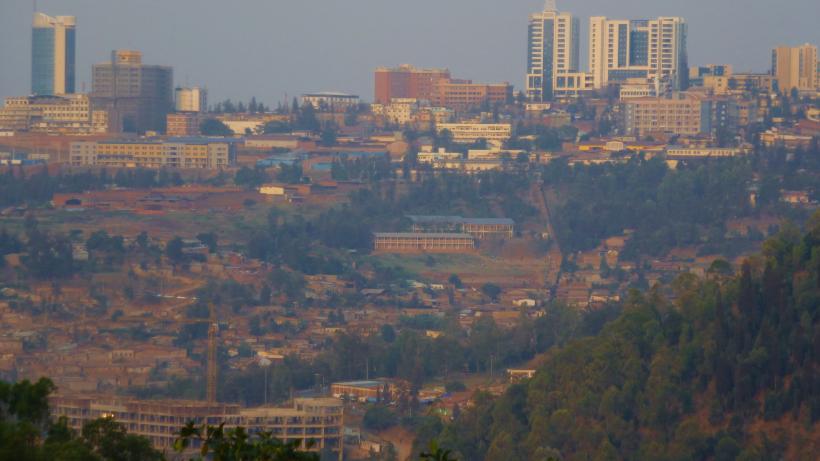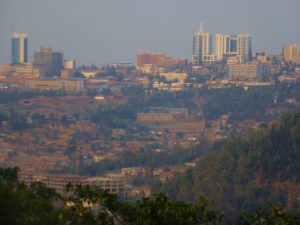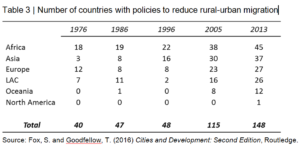
Neglected drivers of urbanisation in Africa
The common assumption that rural-to-urban migration is the primary source of rapid urban population growth in Africa is flawed. Natural population increase within urban areas and rural transformation are also important forces. Policies aimed at easing population pressure in urban areas by discouraging migration are therefore unlikely to succeed.
Most economists and policymakers assume that rural-urban migration is the fundamental driver of urbanisation and urban growth. This assumption has had a profound influence on how the challenges associated with rapid urban population growth have been addressed in many low and middle income countries. But it is a flawed assumption that has led to flawed policies.
Drivers of urbanisation
Urbanisation—i.e. an increase in the share of a country’s population residing in urban areas—happens when urban population growth outpaces rural population growth. Urban population growth is a function of three factors: endogenous population growth (or urban natural increase), in-migration from rural areas, and the transformation of previously rural settlements into urban ones (or reclassification). While migration has received the bulk of attention, there is growing evidence that endogenous urban growth and rural transformation play a far more significant role in driving the process than previously realised.

Urbanisation without migration?
Using DHS data from 23 countries in sub-Saharan Africa I calculated rates of natural population increase broken down by rural and urban residence. Somewhat surprisingly, natural urban growth exceeded natural rural growth in nearly a quarter of the country-years analysed. In other words, in these countries and years urbanisation would have happened without a single person moving from a rural area to an urban one. In some countries natural urban growth regularly outpaces natural increase in rural areas (Table 1).

The differences in sectoral growth rates are generally small, but this observation is important for two reasons. First, the assumption that rapid urban population growth is primarily driven by migration is clearly flawed if urban and rural areas are growing at roughly similar rates. Even without rural-to-urban migration African towns and cities would be growing fast. Second, given the small differences in rural and urban growth rates, even a trickle of migrants is sufficient to drive urbanisation (i.e. an increase in the share of the population living in urban areas) in most countries.
And I argue that there will always be a trickle of net migration from rural to urban areas, regardless of prevailing economic conditions, since the social and economic returns from living in a large community nearly always exceed those of living in a small community. In a city there are more types of jobs to choose from and generally higher wages; there are more potential friends who share similar interests or hobbies; there are more potential husbands or wives or partners; there are more educational opportunities. Urban living enhances freedom and choice. Not always, of course. But on balance big communities have more to offer than small ones, creating a persistent spatial preference for urban living.
Rural transformation
Perhaps counter-intuitively, rural population growth can also contribute directly to urbanisation through the mechanism of rural transformation. This happens when a previously rural landscape is transformed into an urban one through population growth.
Rural transformation is most evident on the fringes of rapidly growing cities as they swallow up rural hinterlands to accommodate new residents and firms. But given that cities were few and far between in Sub-Saharan Africa until relatively recently, it shouldn’t be surprising that rapid population growth has driven the emergence of entirely new cities.
For example, according to a new dataset cataloguing the growth of urban settlements across West Africa, the town of Akatsi in the Volta Region of Ghana grew from an estimated population of just 1600 in 1960 to over 25,000 in 2010. Similarly, Agaie in Niger State, Nigeria had an estimated urban population of 0 in 1970 and over 33,000 in 2010. Both of these settlements are independent of any recognisable metropolitan region; in both cases an urban settlement has emerged in a previously rural landscape.
The quantitative significance of rural transformation as a driver of urbanisation is not yet known, but this new data provides tantalising evidence that it may be large. The number of settlements in West Africa with a population of 10,000 or more increased from just 152 in 1950 to 1,947 in 2010 (Table 2).

The rise and fall of migration-based policy
The “dual sector” conception of urbanisation as a process of relocation from rural to urban areas is misleading. In reality populations are expanding in both rural and urban areas. Against this backdrop of demographic expansion cities are growing rapidly from within, some people are moving into them, and some villages are graduating into settlements of identifiably urban scale. In short, urbanisation has multiple drivers, of which migration is but one (albeit an important one).
This complexity explains why the traditional policy approach to dealing with rapid urban population growth has generally failed. Since at least the late 1970s economists have been encouraging policy makers to put in place measures to restrict or discourage rural-urban migration as a means of promoting development. This advice has widely followed: by 2013 fully 88% of least developed countries (as classified by the UN) had in place policies to lower migration from rural to urban areas—up from 53% in 1996.

These policies clearly haven’t worked. There is no evidence that they have been successful in reducing urban growth rates, urbanisation or poverty. This failure stems from the disproportionate and narrow emphasis on policies designed to influence migration incentives. In practice, people move for many reasons and cities grow in many ways.
Reaping the benefits of urbanisation while minimising the costs
Fortunately there has been a considerable shift in thinking in recent years. Indeed, some countries, such as Rwanda, are now actively seeking to urbanise and even setting urbanisation targets. This is a promising development. But as long as policymakers continue to believe that migration is the primary source of rapid urban population growth, their policies are unlikely to achieve intended goals. A more holistic understanding of urban population change suggests that measures such as family planning initiatives and infrastructure investments in emerging urban centres are likely to yield better returns over the long run than policies that focus on manipulating the location decisions of individuals.

